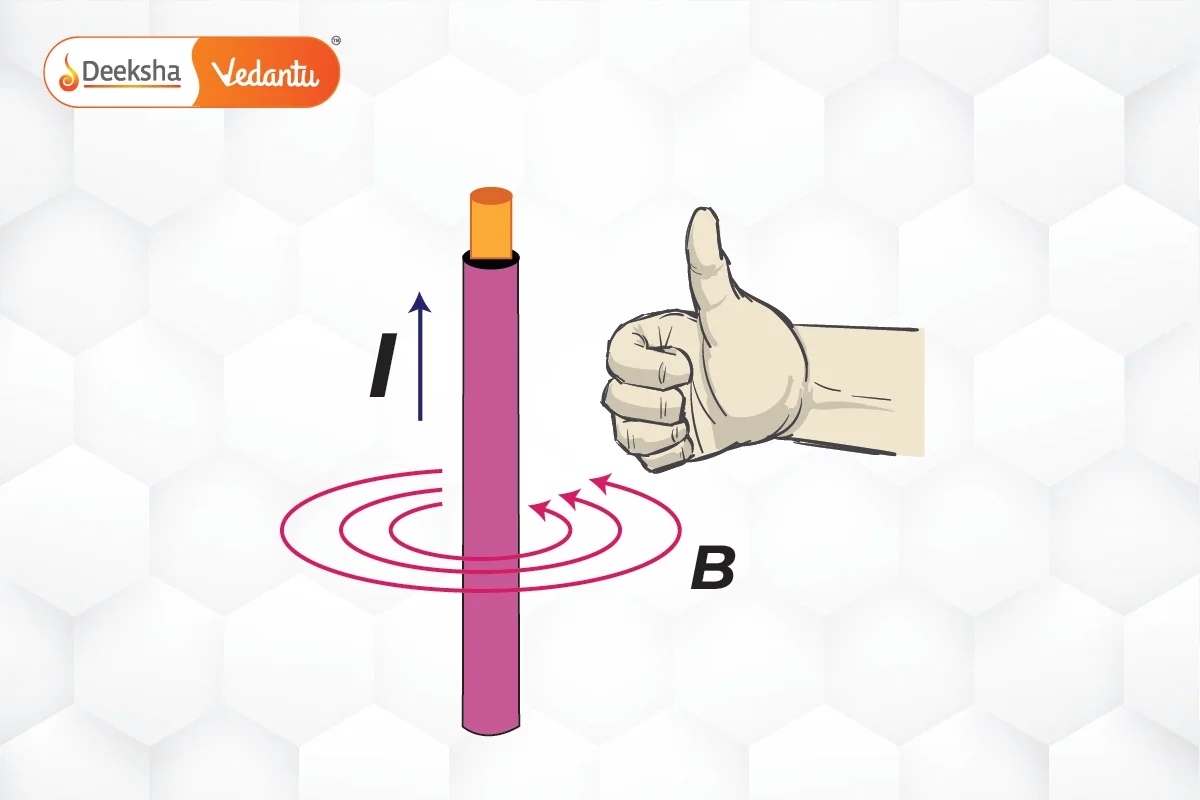Introduction
One of the fundamental discoveries in electromagnetism is that a current-carrying conductor generates a magnetic field around it. This discovery was made by Hans Christian Oersted in 1820, and it established a critical link between electricity and magnetism. The magnetic field produced by a current-carrying conductor behaves similarly to the magnetic field produced by a magnet, but its pattern and direction depend on the shape of the conductor and the direction of the current.
The Right-Hand Thumb Rule helps us determine the direction of the magnetic field generated by a straight conductor. The magnetic field strength also depends on the current’s magnitude and the distance from the conductor.
Magnetic Field Around a Straight Current-Carrying Conductor
When electric current flows through a straight conductor, such as a long wire, a magnetic field is produced around the wire. This magnetic field takes the form of concentric circles centered on the wire, with the wire running through the center of the circles. The magnetic field is strongest near the conductor and weakens as you move away from it.

Key Properties of the Magnetic Field around a Straight Conductor:
- Shape of the Field: The magnetic field forms concentric circles around the conductor.
- Direction of the Field: The direction of the magnetic field depends on the direction of the current and can be determined using the Right-Hand Thumb Rule.
- Strength of the Field: The magnetic field is stronger closer to the conductor and weakens as the distance from the conductor increases.
Right-Hand Thumb Rule
The Right-Hand Thumb Rule (also called Ampere’s Right-Hand Rule) is a simple method used to find the direction of the magnetic field produced by a straight current-carrying conductor.
How to Apply the Right-Hand Thumb Rule:
- Hold the current-carrying conductor in your right hand, with your thumb pointing in the direction of the current.
The curl of your fingers around the conductor indicates the direction of the magnetic field.

Example:
- If the current flows upward through a vertical wire, the magnetic field lines will circle the wire in a counterclockwise direction when viewed from above.
Key Concept:
- Current direction and magnetic field direction are closely linked. If the direction of the current is reversed, the direction of the magnetic field also reverses.
Practice Problem:
- Q: A current flows through a wire from west to east. What is the direction of the magnetic field above and below the wire?
- A: Using the right-hand thumb rule, above the wire, the magnetic field will flow south to north, and below the wire, it will flow north to south.
Factors Affecting the Strength of the Magnetic Field
The strength of the magnetic field produced by a straight current-carrying conductor depends on several factors:
- Current (I): The magnetic field is directly proportional to the current flowing through the conductor. A higher current results in a stronger magnetic field.
- Example: If the current through the wire is doubled, the magnetic field strength will also double.
- Distance from the Conductor (r): The magnetic field strength is inversely proportional to the distance from the conductor. As you move farther away from the wire, the magnetic field weakens.
- Example: At a distance of 2 cm from the conductor, the magnetic field is weaker than it is at 1 cm from the conductor.
Mathematical Representation:
The magnetic field strength (B) at a point near a long straight current-carrying conductor is given by:
Where:
= Magnetic field strength
= Current flowing through the conductor
= Distance from the conductor
Magnetic Field Due to a Circular Loop
When the conductor is bent into a circular loop, the magnetic field at every point on the loop behaves differently from that of a straight conductor.
Key Properties of Magnetic Field in a Circular Loop:
- Magnetic Field Lines: The magnetic field lines near the wire are circular. Inside the loop, the magnetic field lines are nearly straight, and the magnetic field is strongest at the center of the loop.
- Effect of Current: The strength of the magnetic field inside the loop increases with an increase in current.
- Number of Turns (n): If the loop is made up of several turns of wire (a coil), the magnetic field strength increases proportionally to the number of turns. More loops result in a stronger magnetic field inside the coil.

Example:
- In a circular coil with 5 turns, if the current is increased, or the number of turns is doubled, the magnetic field strength at the center of the loop will increase significantly.
Practice Problem:
- Q: A circular loop carries a current of 5 A. If the number of turns in the loop is increased from 10 to 20, what happens to the magnetic field at the center of the loop?
- A: The magnetic field will double, as the number of turns has doubled.
Magnetic Field Due to a Solenoid
A solenoid is a long coil of wire with many turns, often used to create strong magnetic fields. When an electric current flows through a solenoid, the magnetic field inside the solenoid is uniform and resembles the field of a bar magnet.

Key Properties of a Solenoid:
- Uniform Magnetic Field: The magnetic field inside the solenoid is nearly uniform and strong. The field lines inside the solenoid are parallel, indicating a consistent field strength.
- North and South Poles: The solenoid behaves like a bar magnet, with distinct north and south poles depending on the direction of the current.
- Electromagnet: By placing a soft iron core inside the solenoid, you can create a powerful electromagnet. The soft iron core enhances the strength of the magnetic field.
Example of a Solenoid:
- A solenoid is used in electromagnetic devices such as electric bells, electric motors, and relays.
Real-Life Applications of Magnetic Fields Produced by Current-Carrying Conductors
Electric Motors: Electric motors convert electrical energy into mechanical energy using the interaction between a current-carrying conductor and a magnetic field. The magnetic force causes a current-carrying coil to rotate inside the motor.
Electromagnets: Electromagnets are used in devices like magnetic cranes, electric bells, and loudspeakers. By passing current through a coil of wire (solenoid), a strong magnetic field is generated, which can be controlled by adjusting the current.
Magnetic Cranes: Magnetic cranes use powerful electromagnets to lift and move heavy metal objects, such as scrap iron. The strength of the magnetic field can be turned on and off by controlling the current.
Magnetic Levitation (Maglev) Trains: Maglev trains use powerful magnetic fields to float above the tracks, reducing friction and allowing the trains to move at high speeds. The interaction between the magnetic fields generated by the train and the tracks allows for smooth, fast movement.
Key Practice Questions
Q1: Draw the magnetic field lines around a straight current-carrying conductor. Describe the direction of the field lines using the right-hand thumb rule.
- Answer: The magnetic field lines around a straight current-carrying conductor form concentric circles. Using the right-hand thumb rule, if the current flows upward, the magnetic field lines will circle the conductor in a counterclockwise direction when viewed from above.
Q2: A wire carries a current of 3 A. If the current is doubled, what happens to the magnetic field around the wire?
- Answer: The magnetic field around the wire will also double, as the magnetic field strength is directly proportional to the current flowing through the wire.
Q3: A solenoid has 100 turns of wire and carries a current of 2 A. If the number of turns is increased to 200, what happens to the magnetic field inside the solenoid?
- Answer: The magnetic field inside the solenoid will double, as the magnetic field strength increases with the number of turns.
Q4: Describe how an electromagnet is created using a solenoid.
- Answer: An electromagnet is created by passing a current through a solenoid with a soft iron core inside it. The current generates a magnetic field, and the soft iron core enhances the strength of the field, making the solenoid act like a strong magnet.
FAQs
Related Topics
- Laws of Motion
- Compound Microscope
- Electric Potential And Potential Difference
- Kirchhoff’s Law
- Noise Pollution
- Fleming’s Left-Hand Rule and Right-Hand Rule
- Ohm’s Law
- Force On A Current – Carrying Conductor In A Magnetic Field
- The Human Eye And The Colourful World
- Heating Effect Of Electric Current
- Magnetic Effects Of Electric Current
- Difference between AC and DC
- Atmospheric Refraction
- Velocity
- Full Wave Rectifier











Get Social